
Pest & Crop
Newsletter
Purdue Cooperative Extension Service

Purdue Cooperative Extension Service
Issue 16, July 16, 2015 • USDA-NIFA Extension IPM Grant
CLICK HERE FOR A PDF VERSION OF THIS ISSUE ![]()
The lyrics of that well-known Irving Berlin song have been a favorite selection on the well-worn jukebox down at the Chat ‘n Chew Café in recent weeks as farmers yearn for a return to sunshine and warmth to rejuvenate the appearance of their water-logged corn fields. The seemingly incessant occurrence of depressingly cloudy days seems to add insult to injury as crops already stunted by saturated soils and nitrogen deficiency struggle to recover.
How much damage can these cloudy days cause to a corn crop? The primary effect of cloudy days is obviously the reduction in solar radiation levels and the subsequent reduction of photosynthetic rates by the plants. For crops that are struggling to recover from severe stress or damage, a reduction in available photosynthate slows the recovery process and possibly "tips the scales" in favor of unrecoverable yield loss due to stunted growth or plant death.
For otherwise healthy crops, restricted photosynthate supply caused by cloudy weather prior to pollination results in smaller plants, but likely does not affect ovule development (ear size determination) very much. However, the "snowball" effect of smaller plants later during pollination and grain fill is that kernel abortion may increase and kernel weight may decrease if the smaller plants cannot produce adequate amounts of photosynthate.
Restricted photosynthate supply caused by cloudy weather during pollination may interfere with the synchrony of silk emergence and pollen shed, resulting in noticeable numbers of non-fertilized ovules or "blanks" on the cob. One potential sign of asynchronous silk / pollen availability is the presence of longer than expected emerged silks (Nielsen, 2015). Abortion of newly fertilized ovules may also occur when pollination occurs in a string of intensely cloudy days, leaving behind "blanks" that can misinterpreted as due to pollination failure.
Restricted photosynthate supply caused by cloudy weather during the grain fill period can cause abortion of young kernels at the blister (R2) and milk (R3) stages of development or reduction in kernel weight through the remainder of the grain fill period.
Estimates of potential yield loss due to cloudy weather come from studies where plants were shaded artificially at different times and durations. Many of the trials evaluated the effects of treatments of continuous 50% shading for 2 to 4 weeks or longer, which is quite unrealistic from a real world perspective.
Suffice it to say that yield losses can occur, perhaps even significantly, due to a combination of reduced kernel numbers per ear and reduced weight per kernel, both as a consequence of reduced photosynthate availability during pollination and/or grain filling. This is true regardless of the cause of reduced photosynthate availability (cloudiness, drought stress, foliar diseases, nutrient deficiencies).
The magnitude of the shade-induced reductions in yield components obviously depends on the severity of the shading (cloudiness) and the duration, especially relative to number of consecutive days of intensely cloudy weather. While we may think there have been many intensely cloudy days this season, the number of days with solar radiation less than 50% of maximum has been relatively low. For example, at the Davis-Purdue Ag Center in eastern Indiana, there have only been 18 to 20 days with 50% or less of maximum solar radiation from May 1 through July 12 (iClimate.org), with never more than 3 consecutive days of such cloud cover.
Interesting Note: Several studies document a positive relationship between high plant population tolerance of hybrids with higher tolerance to shading. This makes sense from the perspective that one of the consequences of higher plant populations is increased shading of individual plants' leaves.
“Blue Skies smiling at me, Nothing but Blue Skies do I see …” (Irving Berlin, 1927).
Earley, E. B., R. J. Miller, G. L. Reichert, R. H. Hageman, and R. D. Seif. 1966. Effect of Shade on Maize Production Under Field Conditions. Crop Sci. 6: 1–7.
Earley, E. B., McIlrath, W. O., Seif, R. D. & Hageman, R. H. 1967. Effects of Shade Applied at Different Stages of Plant Development on Corn (Zea mays L.) Production. Crop Sci. 7: 151–156.
Hashemi-Desfouli, A. and S. J. Herbert. 1992. Intensifying Plant Density Response of Corn with Artificial Shade. Agron. J. 84:547-551.
Liu, W. and M. Tollenaar, 2009. Physiological mechanisms underlying heterosis for shade tolerance in maize. Crop Sci. 49:1817–1826.
Nielsen, RL (Bob). 2011. Kernel Set Scuttlebutt. Corny News Network, Purdue Extension. http://www.kingcorn.org/news/timeless/KernelSet.html [URL accessed July 2015].
Nielsen, RL (Bob). 2015. Unusually Long Silks in Corn. Corny News Network, Purdue Extension. http://www.kingcorn.org/news/timeless/LongSilks.html [URL accessed July 2015].
Reed, A., G. Singletary, J. Schussler, D. Williamson and A. Christy, 1988. Shading effects on dry matter and nitrogen partitioning, kernel number, and yield of maize. Crop Sci. 28: 819–825.
Wiebold, Bill. 2013. Increased Arrested Development of Corn Kernels May Have Resulted from Cloudy Weather. Integrated Pest & Crop Management Newsletter, Univ. of Missouri. http://ipm.missouri.edu/IPCM/2013/9/Increased-Arrested-Development-of-Corn-Kernels-May-Have-Resulted-from-Cloudy-Weather. [URL accessed July 2015].
The other day, a patron of Rudy's Bar and Grill walks in with an ear of corn that exhibits long, flowing locks of blonde silks tumbling down the sides of the husk leaves and asks two questions: "Why are the silks so long?" and "Do such long silks bode ill for the success of corn pollination?"
Both questions suggest that the guy has some experience thinking about sex in a corn field and understands that silks are the functional stigmas of the female flowers of a corn plant. Each silk connects to an individual ovule (potential kernel) and must be pollinated in order for fertilization of the ovule to occur and a kernel develop. The guy also seems to know that emerged silks are typically only 2 to 3 inches long; not 6 to 9 inches long like those on the ear he brought in.
Silks begin elongating from the ovules near the base of an ear shoot sometime around leaf stage V12 to V14, followed by silk elongation from the remaining ovules of the ear shoot, sequentially from base to tip of ear. The silks from ovules from the lower third of the cob are typically the first to emerge through the husk leaves; followed sequentially by the remaining silks over a 4 to 8 day period.
Emerged silks initially lengthen from 1 to 2 inches per day, but then slow over the next few days due to natural aging or the inhibition caused by "captured" pollen grains as they germinate and initiate pollen tubes that penetrate the silk and elongate toward the ovule. The latter inhibition of silk elongation occurs within about 12 hours of pollination, if not earlier. Without pollination, silk elongation will slow to a stop within about 9 days after emergence.
Most of us "gray beard" agronomists were taught that full tassel emergence (growth stage VT) often occurred 2 to 3 days before the first emergence of silks (growth stage R1). In fact, the verbatim definition of the VT stage from Ritchie et al. (1993) was that "The VT stage is initiated when the last branch of the tassel is completely visible and the silks have not yet emerged." Furthermore, pollen shed often began before or just at the timing of silk emergence.
Corn field aficionados will tell you that the timing of tassel emergence / pollen shed / silk emergence has changed somewhat in some of today's hybrids. In my own demo plots at the Purdue Crop Diagnostic Training & Research Center, it is not uncommon for silks to begin emerging before the tips of the tassels are evident from the upper leaf whorl. Sometimes pollen shed begins 2 to 4 days AFTER the initial emergence of silks from the ear husks. Such early silk emergence in modern hybrids is partially due to genetic improvement for drought tolerance that decreases the risk of delayed silk emergence in the presence of drought stress. This more robust silk elongation can result in unusually early silk emergence when growing conditions are more favorable (personal communication, K. Cavanaugh, Becks Hybrids).
Relatively cool temperatures, cloudy weather, and ample soil moisture promote sustained silk elongation. Coupled with hybrids that may silk one or more days prior to pollen shed from the tassel, silk lengths can become quite impressive. This year, I have measured exposed silks as long as nine inches.
Can there be a downside to such wonderfully long, voluptuous, silky...........silks? Well, yes, there is a risk that kernel set near the base of the cob may suffer if the initial emerged silks deteriorate enough prior to pollen shed that they become non-receptive. Kernel set near the butt end of the cob may also suffer if later-emerging silks from higher up on the ear "shade" or otherwise obstruct the initial emerged silks from "capturing" pollen. The images below illustrate the potential for non-pollinated areas near the base of the cob in a hybrid that silked several days prior to the beginning of pollen shed.
 Fig. 1. Truly waterlogged soil. Plants severely stunted.
Fig. 1. Truly waterlogged soil. Plants severely stunted.
 Fig. 2. Roots damaged by saturated soils. Acceptable plant recovery not likely.
Fig. 2. Roots damaged by saturated soils. Acceptable plant recovery not likely.
 Fig. 3. Waterlogged field of corn. Plants stunted, lower leaves "fired", upper canopy yellow-green.
Fig. 3. Waterlogged field of corn. Plants stunted, lower leaves "fired", upper canopy yellow-green.
While unusually long silks are, well, unusual, don't get overly pessimistic about the prospects of poor kernel set as a consequence. Time spent now walking fields during the early stages of grain fill may help provide an overview of the extent of the problem if any.
Bassetti, Paolo and Mark Westgate. 1993. Emergence, Elongation, and Senescence of Maize Silks. Crop Sci. 33:271-275.
Cárcova, J., B. Andrieu, and M.E. Otegui. 2003. Silk Elongation in Maize: Relationship with Flower Development and Pollination. Crop Sci. 43:914-920.
Nielsen, RL (Bob). 2011. Kernel Set Scuttlebutt. Corny News Network, Purdue Extension. http://www.kingcorn.org/news/timeless/KernelSet.html [URL accessed July 2015].
Nielsen, RL (Bob). 2012. A Fast & Accurate Pregnancy Test for Corn. Corny News Network, Purdue Extension. http://www.kingcorn.org/news/timeless/EarShake.html [URL accessed July 2015].
Nielsen, RL (Bob). 2014. Silk Emergence. Corny News Network, Purdue Univ. [online] http://www.kingcorn.org/news/timeless/silks.html [URL accessed July 2015].
Ritchie, S.W., J.J. Hanway, and G.O. Benson. 1993. How a Corn Plant Develops. Iowa State Univ. Sp. Rpt. 48.
Sella Kapu, Nuwan Umantha. 2006. Pollination-induced inhibition of maize silk elongation. Ph.D. Dissertation, Penn. State Univ.
One of the concerns with the seemingly incessant ponding or saturation of corn fields around Indiana early this growing season is that the stress imposed by waterlogged, oxygen-deficient soils on corn plants during their rapid growth phase will reduce the ear size potential. If true, then yield potential will be limited regardless of whether the weather moderates for the remainder of the growing season.
The uppermost primary ear of a corn plant is initiated at approximately growth stage V5 (five leaves with visible leaf collars). The maximum number of potential kernel rows (ear girth) on the ear is complete by about V7. Subsequent initiation of ovules for each row (ear length) occurs sequentially from the base of the cob to the tip over several weeks. Ear size determination is thought to be complete by V12 to V14. Severe stress occurring during ear size determination can decrease the potential ear size (reduced ovule numbers). See my 2007 article for more information and photos (Nielsen, 2007).
Ovule row number determination is relatively tolerant to stress due, in part, to it being a relatively strong hereditary trait and also because maximum ovule row number determination occurs over a relatively short time period (2 to 3 leaf stages or about 6 to 9 days). Ovule number per row is relatively more vulnerable to stress for the opposite reasons... less of a hereditary trait (more responsive to growing conditions) and a longer time period for development (more opportunity to experience severe stresses).
Interestingly, our research with corn responses to nitrogen (N) fertilizer rates and plant populations suggests that ear size determination is relatively unaffected by severe N deficiency or excessively high plant populations during the vegetative stages of development. Yield reductions due to either stress are due more so to reductions in actual kernel number (pollination failure and kernel abortion) and kernel weight.
So, what about the stress imposed on plants when they are faced with saturated soils or outright ponding during the ear size determination period? We do not have much data at all on this, but I checked some plants the other day in a partially ponded field to obtain some serendipitous, non-replicated data. The accompanying photos illustrate what I found in this limited sampling of plants. Take it with two grains of salt.
I removed silking ears from three random relatively healthy plants in a relatively unaffected area of the field and lesser developed ear shoots from three random stunted plants from an area that has been ponded and saturated multiple times since early June. The latter plants were certainly not as severely stunted as some of what we see around the state these days, but neveretheless represent quite a bit of the stunted corn that one might consider salvageable (Nielsen, 2015).
The development of the ear shoots removed from the stunted, waterlogged plants was distinctly delayed relative to those from the healthier plants. The latter were in the early stages of silk emergence (R1), while those of the nearby stunted plants were only in the initial stages of silk elongation within the husk leaves. Silk emergence of the stunted plants will likely be at least a week delayed.
Surprisingly, ovule numbers per row were identical between the ears of the healthy and stunted plants (42). Considering that kernel numbers per row at harvest typically range from 30 to 35, those ovule numbers are certainly acceptable and fairly normal.
However, ovule row numbers were less on the ears from the stunted, waterlogged plants (14 versus 18). Specifically, the ovule row numbers at the very base of the cobs were the same as the healthy ears, but within a few ovules from the base of the cobs, two pairs of ovule rows "disappeared".
Ovule paired rows initially develop as single spikelet primordia rows that eventually divide into pairs as ovule development proceeds from base to tip of the cob during ear size determination. With the ears from the waterlogged plants, it appears that two spikelet primordia rows (potential paired rows) appeared to have simply aborted shortly after they were initiated. This circumstantial evidence suggests that, in addition to being waterlogged recently, these plants were also waterlogged near the V7 growth stage and stressed enough to cause the abortion of potential kernel rows very early in their development.
That may be more than you cared to read about, but the upshot of situations like this is that the potential loss in yield potential from aborted rows of potential kernels can be quite large. Using the traditional yield estimation formula (Nielsen, 2014) and a harvest population of 32,000 ears per acre, one can estimate the potential yield loss.
For the sake of argument, I will further assume that a "typical" 18-row ear of corn would have no more than 30 harvestable kernels at a population of 32,000, while a "typical" 14-row ear often has upwards of 35 harvestable kernels. Given those assumptions, the potential yield of the healthier plants in the field would be about 216 bu/ac (18 x 30 x 32 divided by 80) while the potential yield of the stunted plants (assuming equal kernel weights) would be about...................... 196 bu/ac (14 x 35 x 32 divided by 80). Certainly, one can play various "what if" scenarios with the yield estimation formulas by changing harvestable kernel numbers and kernel weight (fudge factors), but nevertheless the closeness of the yield estimates is astounding.
Among the unknowns with such estimates are a) whether the eventual pollination in the stunted and delayed ponded areas will be successful, b) whether kernel abortion rates will be significantly higher with the stunted plants, and c) whether kernel weights will be compromised due to the stunted plant development. Additionally, there is also the lingering question about whether available soil N is adequate to sustain kernel development in the waterlogged areas of fields.
A lot of unknowns, but that is par for the course when faced with the extreme weather events like we are experiencing in 2015.
Food for thought. Take it for what it is worth.
 Waterlogged (right) vs healthier (left) plants.
Waterlogged (right) vs healthier (left) plants.
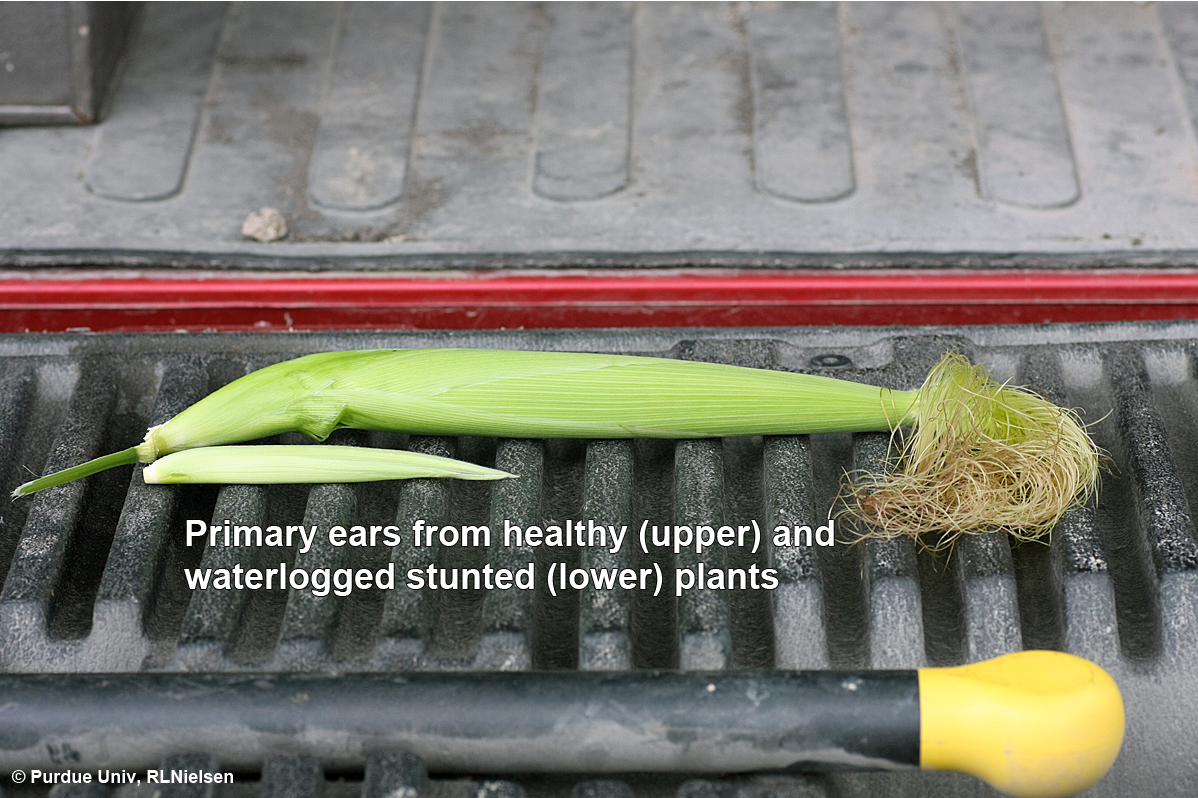 Primary ears from healthy (upper) and waterlogged stunted (lower) plants.
Primary ears from healthy (upper) and waterlogged stunted (lower) plants.
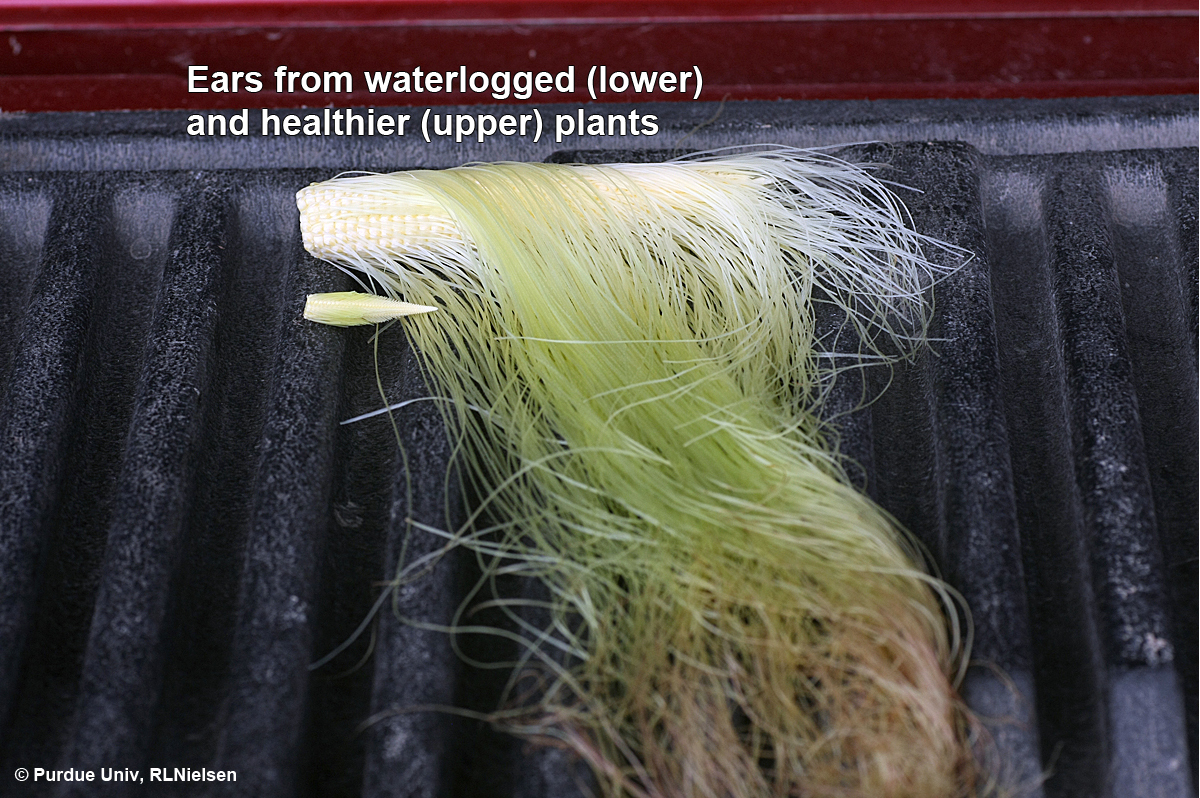 Ears from waterlogged (lower) and healthier (upper) plants.
Ears from waterlogged (lower) and healthier (upper) plants.
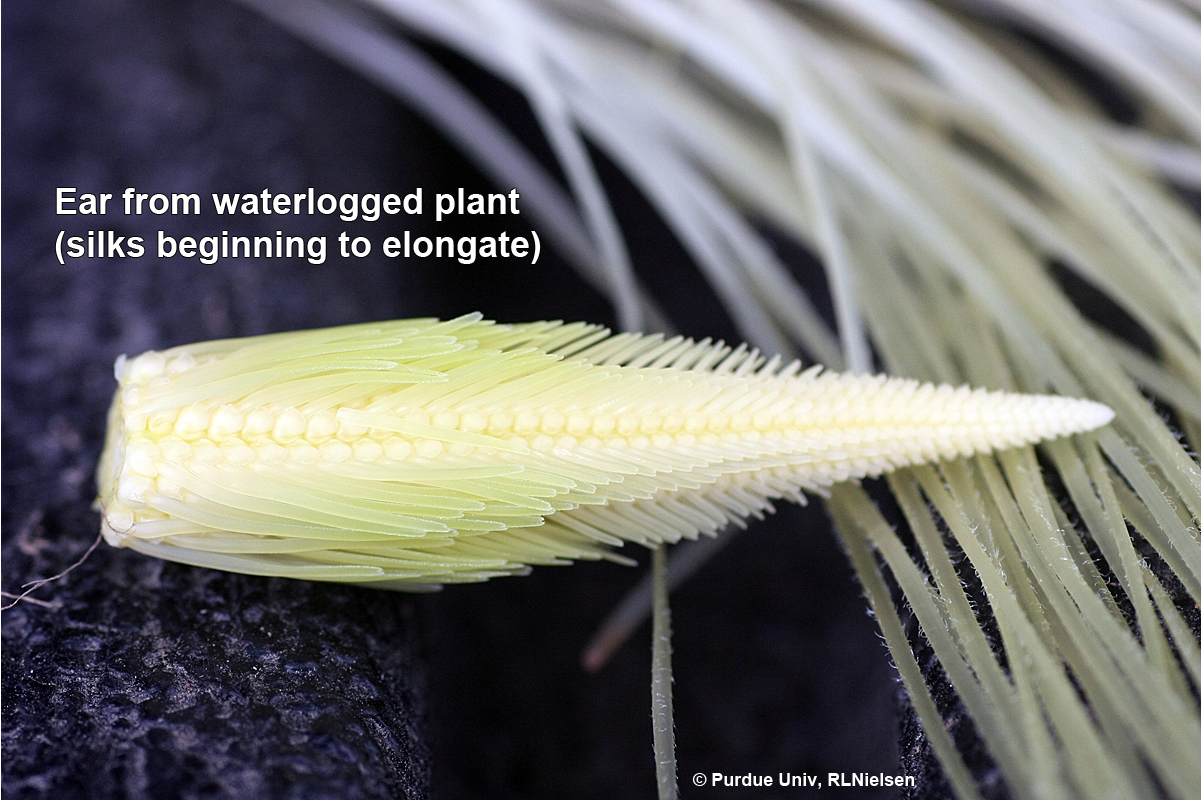 Ear from waterlogged plant (silks beginning to elongate).
Ear from waterlogged plant (silks beginning to elongate).
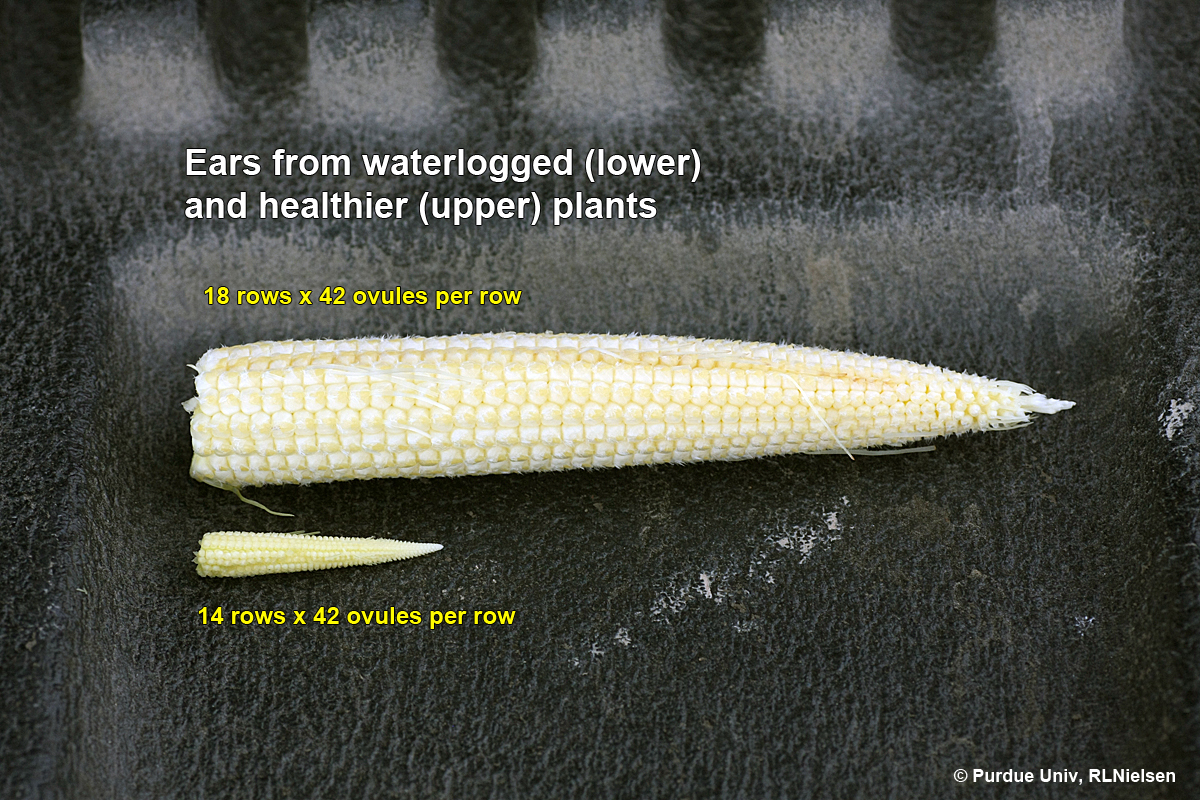 Ears from waterlogged (lower) and healthier (upper) plants.
Ears from waterlogged (lower) and healthier (upper) plants.
Nielsen, RL (Bob). 2007. Ear Size Determination in Corn. Corny News Network, Purdue Extension. http://www.kingcorn.org/news/timeless/EarSize.html [URL accessed July 2015].
Nielsen, RL (Bob). 2014. Estimating Corn Grain Yield Prior to Harvest. Corny News Network, Purdue Extension. http://www.kingcorn.org/news/timeless/YldEstMethod.html [URL accessed July 2015].
Nielsen, RL (Bob). 2015. Salvageability of Waterlogged Fields of Corn: That's the $64 Question. Corny News Network, Purdue Extension. http://www.kingcorn.org/news/articles_15/WaterloggedCorn_0707.html [URL accessed July 2015].
Adjuvants are very useful products which are used to enhance the activity of postemergence herbicides. Numerous adjuvant products from very reliable distributors are marketed annually and provide a true value to growers seeking to optimize herbicide performance.. However, since the adjuvant industry is not regulated as stringently as the pesticide industry, we occasionally run into products that create a lot of attention because of extravagant claims made by the manufacturer or distributor.
Nanotechnology is a new and exciting area of research and product development in numerous sectors. Agrochemicals, including adjuvants, are being developed with nanotechnology and may very well have substantial benefits. However, during our winter grower meeting season, we began to hear rumblings about certain “nano” adjuvants and how they provided the answers for control of herbicide-resistant weeds. Our concern grew after reviewing the marketing material that inaccurately describes the underlying mechanisms of herbicide resistance and the suggestion that the only necessary action to control glyphosate-resistant weeds was to apply glyphosate with the nano adjuvant. The nano adjuvants purportedly would overcome resistance mechanisms and by promoting higher levels of herbicide penetration into the plant. No scientific evidence exists that would suggest weed resistance to glyphosate is simply a lack of foliar absorption. Nonetheless, we were getting phone calls about their utility and were hearing claims that there was university data to support their claims. However, we at Purdue University had not worked with these compounds, nor were we aware of university data supporting their use.
Below is a copy of the “technical” data information provided by the distributors for two nano adjuvants, one of these was being marketed in Northern Indiana. A number of interesting claims are made on these documents, which you can read below.
 Short Sheet: Combating Herbicide Resistance with ChemXcel.
Short Sheet: Combating Herbicide Resistance with ChemXcel.
In an effort to learn more about the utility of these adjuvants, we conducted a study at a site in Indiana with glyphosate-resistant Palmer amaranth and wanted to share the results in this article. Dr. Young has also collaborated with a number of other weed scientists throughout the Midwest to conduct similar trials and we will share the results as they come available.
Our trial was on glyphosate-resistant Palmer amaranth with a population of about 95% resistant:5% susceptible. Control with glyphosate alone was 13.8%. There was a 5% increase in activity with one of these adjuvants at 27 DAT compared to glyphosate alone, but that only raised the level of control to 18% which is still well below commercially acceptable levels. In other words, the nano adjuvants tested did not solve weed resistance to glyphosate.
Adjuvants are critical components of making effective herbicide applications to control our most problematic weeds. However, the simple addition of an adjuvant to resolve weed resistance to herbicides does not exist. Be critical of any marketing claims that sound too good to be true, because most of the time they are.
| Herbicide | Rate | Control at 27 DAT (%) |
|---|---|---|
| Roundup PowerMax | 22 fl oz/a | 13.8 b |
| Roundup PowerMax AMS | 22 fl oz/a 8.5 lb/100 gal |
13.8 b |
| NanoRevolution 2.0 | 4 fl oz/a | 0.0 c |
| ChemXcel | X4 fl oz/a | 0.0 c |
| Roundup PowerMax NanoRevollution 2.0 | 22 fl oz/a 4 fl oz/a |
18.3 a |
| Roundup PowerMax ChemXcel | 22 fl oz/a 4 fl oz/a |
15.0 ab |
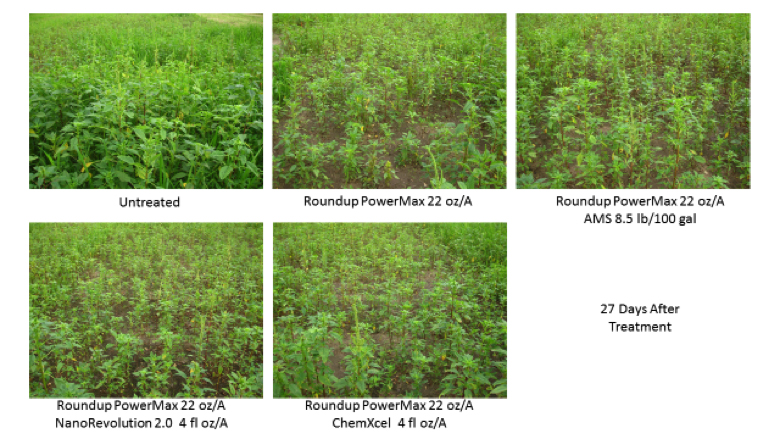 27 Days after treatment.
27 Days after treatment.
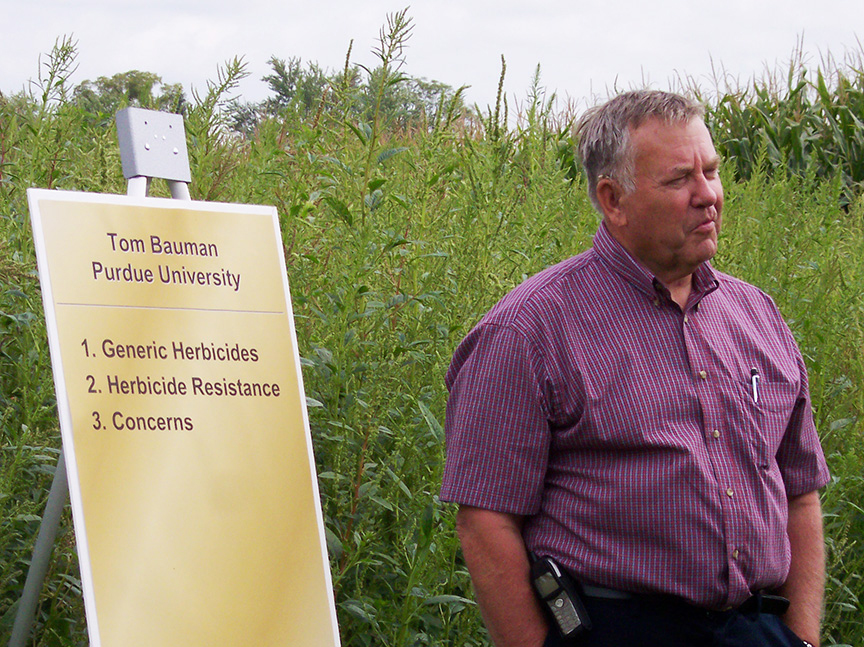 Tom Bauman (1939-2015)
Tom Bauman (1939-2015)
Dr. Thomas Trost Bauman, Professor Emeritus, passed away Saturday July 11, 2015 at his home in West Lafayette.
Born September 11, 1939 in Lafayette, he was the son of Ronald Hawkins Bauman and Martha G. (Trost) Bauman. He is survived by his loving wife of nearly 50 years, Nancy L. (Sahnd). They were married on August 14, 1965 in Cincinnati, OH.
He attended Purdue University, receiving a B.S., M.S., and PhD in Agriculture. He was a member of Sigma Alpha Epsilon fraternity. Following in his father's footsteps as a professor at his alma mater, he was appointed to the Botany and Plant Pathology Department, with a focus on Extension and Research. Tom and his students were well published in both scientific and Extension journals. He was awarded Master Farmer distinction in 2010. Tom's work was acknowledged worldwide and he was fortunate to frequently travel internationally to share his work; he particularly enjoyed his extensive efforts in Brazil and remained close friends with many Brazilian scientists.
Although Tom was internationally recognized, he was humble and took his greatest joy in helping to train young people, future scientists and simply farming the black Indiana soil, whether it be corn, beans, weeds, or the greatest of hybrid sweet corn. Tom was a caring, kind, concerned person, especially sensitive to his graduate students and those who worked with him in the field. He respected Indiana farmers and enjoyed his many meetings with them, particularly his annual field day at the Purdue Agronomy Farm.
A visitation will be held from 1:00 pm until 2:30 pm in the Central Presbyterian Church parlor with a memorial service to follow at 2:30 pm on Friday, July 17, 2015. In lieu of flowers, contributions may be made to the Central Presbyterian Building and Grounds Fund; West Lafayette Schools Education Foundation, or St. Elizabeth Hospice.
The wet weather across the state has been favorable for the development of foliar soybean diseases. Two diseases that are appearing in soybean fields are the fungal disease Septoria brown spot, (caused by Septoria glycines, and commonly referred to as brown spot), and bacterial blight. These diseases have similar symptoms, but it is important to accurately identify the disease issue in a field before applying a fungicide for disease management. In my recent field visits across the state, bacterial blight is the primary disease in the upper canopy, particularly in the northern part of the state, and brown spot is still confined to the lower canopy in soybeans across the state.
How do we distinguish between these two diseases? Leaves infected by Pseudomonas sp. bacteria have brown angular lesions that are surrounded by a yellow ring or halo, and may have a water-soaked appearance. As lesions age, they turn dark brown and fall out of the leaf tissue, giving leaves a tattered appearance (Figure 1). Bacteria survive on soybean residue and in seed, and enter plants through stomates and wounds caused by equipment or other mechanical damage, or from weather events such as heavy rains, wind, and hail. Long periods of leaf wetness and cool weather favor infection. Hot, dry weather will limit disease development. Yield loss may occur if disease is severe and plants defoliate. However, most fields in Indiana exhibiting symptoms of bacterial blight are only lightly to moderately affected by the disease and we would not expect to see yield loss due to this disease in these fields.
Symptoms of brown spot are typically observed in the lower canopy first, and are characterized by brown to black spots on upper and lower leaf surfaces (Figure 2). Lesions may or may not have the yellow halo of bacterial blight lesions, but leaves with lesions can turn yellow due to senescence (Figure 3). Research indicates yield reduction from this disease will be minimal if it stays confined to the lower 2/3 of the canopy.
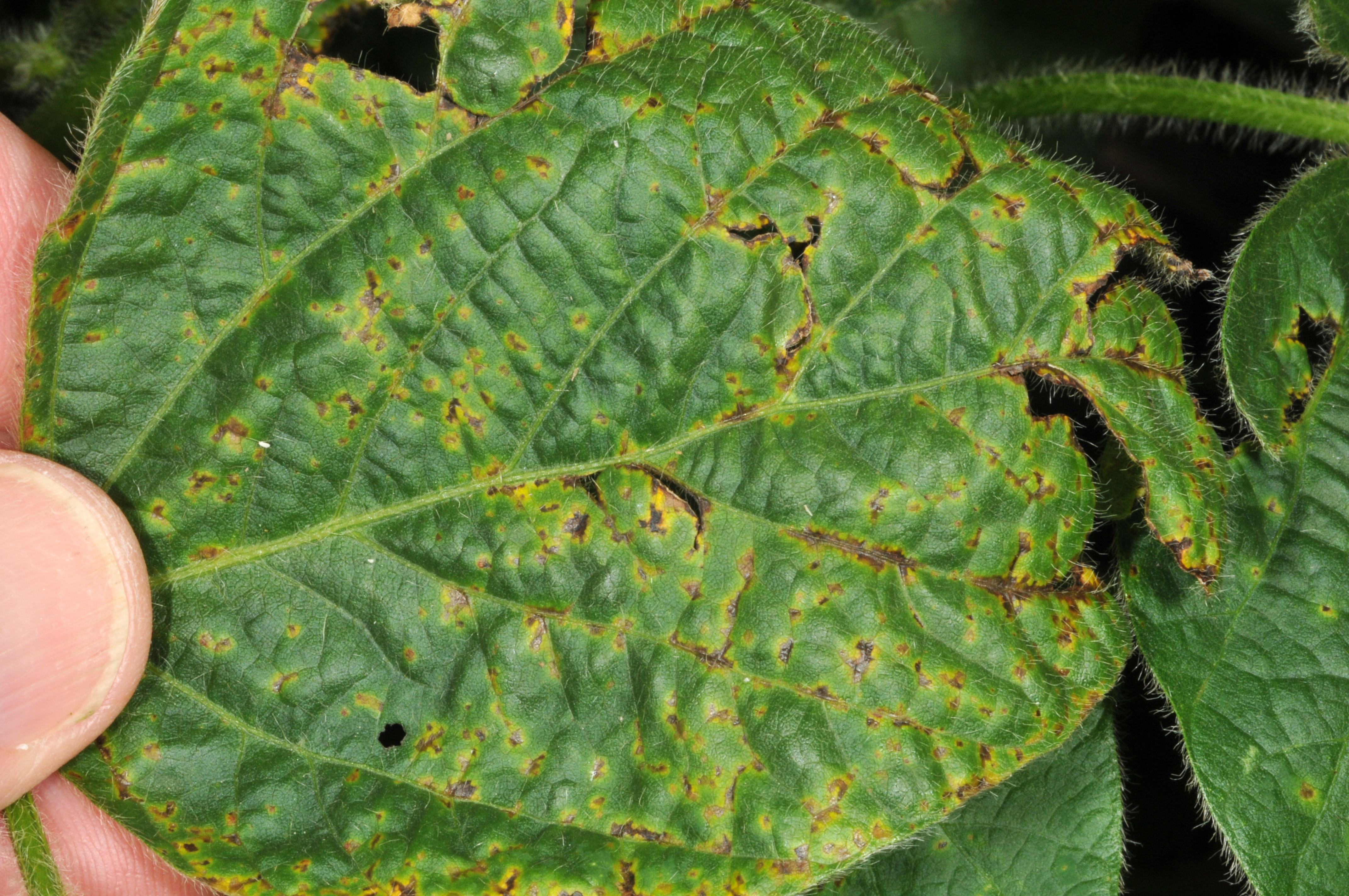 Figure 1. Angular lesions with a yellow halo and tattered leaves in the upper canopy are symptomatic of bacterial blight. (Picture courtesy Corey Gerber).
Figure 1. Angular lesions with a yellow halo and tattered leaves in the upper canopy are symptomatic of bacterial blight. (Picture courtesy Corey Gerber).
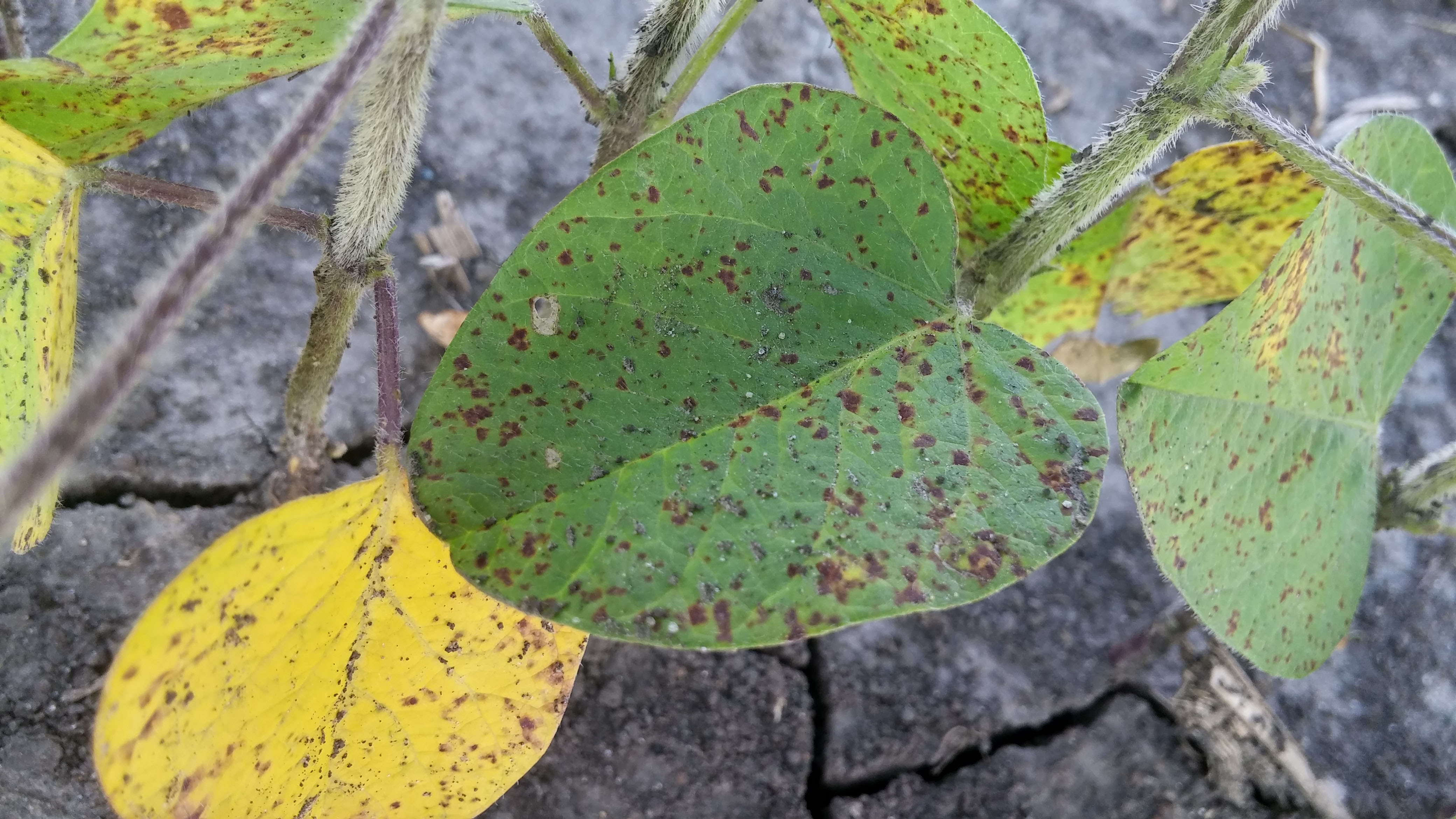 Figure 2. Early symptoms of brown spot.
Figure 2. Early symptoms of brown spot.
 Figure 3. Late symptoms of brown spot on soybean.
Figure 3. Late symptoms of brown spot on soybean.
Preventative management options for both diseases include crop rotation, tillage, and planting less susceptible varieties. These methods can lower the risk of disease developing in the subsequent soybean crop. Fungicides will not manage bacterial blight. Fungicide applications for brown spot are rarely warranted and may not be consistently profitable.
A past video comparing symptoms of bacterial blight and brown spot is available here:
The pattern of frequent rainfall, high humidity and moderate temperatures has continued across Indiana. Scouting reports indicate that disease severity varies in fields across the state. Corn across much of southern Indiana has pollinated and disease levels remain low or confined to the lower canopy, with some exceptions. Northern corn leaf blight and gray leaf spot are appearing more frequently in corn that is tasseling or pollinating in central and northern Indiana. Corn that will be at this critical stage over the next two weeks should be scouted for diseases to determine if fungicide applications are warranted. So far in July, the main disease concern has been northern corn leaf blight (NCLB), but as temperatures increase over the next week it will be important to assess gray leaf spot levels as well.
Before deciding on whether or not to apply fungicides, keep this in mind: The condition of corn in Indiana varies widely, and farmers should think carefully before making decisions to add inputs into their crop. Because of tight margins and poor crop condition, it is very important to scout fields this year and check hybrid resistance ratings prior to fungicide application. This information can be used to help determine if a fungicide application is needed in a given field.Iowa State University developed guidelines to determine when a fungicide may be necessary to prevent yield loss from gray leaf spot. These thresholds incorporate hybrid susceptibility ratings to gray leaf spot and disease levels prior to tasseling:
The hybrid is rated as susceptible or moderately susceptible AND 50 percent of the plants in a field have disease lesions present on the third leaf below the ear leaf or higher prior to tasseling.
The hybrid is rated as moderately resistant AND 50 percent of the plants in a field have disease lesions present on the third leaf below the ear leaf or higher prior to tasseling AND additional factors or conditions that favor disease development are present (residue present, favorable weather conditions)
Scout resistant hybrids for disease problems, but in general, fungicide applications to resistant hybrids are not recommended and will not consistently result in increased yield. For more information on gray leaf spot, please read Purdue Extension bulletin BP-056-W: http://www.extension.purdue.edu/extmedia/bp/BP-56-W.pdf.
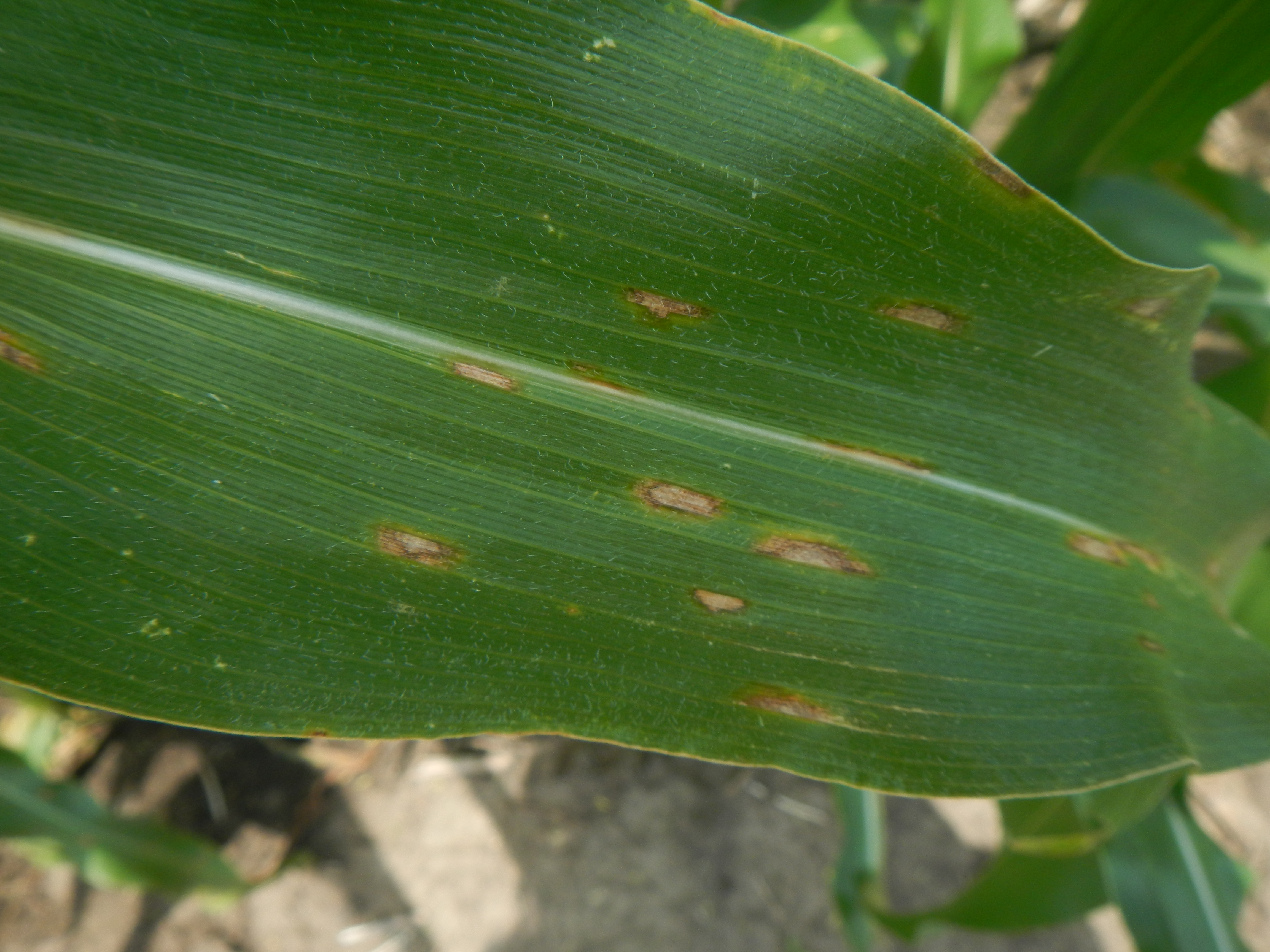 Figure 1. Gray leaf spot on corn.
Figure 1. Gray leaf spot on corn.
We discussed the scouting thresholds and considerations for NCLB management in a previous P&C article that can be found here: http://extension.entm.purdue.edu/pestcrop/2015/Issue13/. Briefly, scouting fields around V14, or just prior to tassel emergence, can help determine the level of disease pressure in a field. When scouting, if 50 percent of the plants in a field have disease lesions present AND additional factors or conditions that favor disease development are in play (residue present, favorable weather conditions) a fungicide application may be warranted. Research in Indiana indicates that fungicides are most effective at preventing yield loss due to NCLB when applied at the tasseling to early silking (VT-R1) growth stage. For more information on northern corn leaf blight, please read Purdue Extension bulletin BP-084-W: http://www.extension.purdue.edu/extmedia/BP/BP-84-W.pdf.
Fungicide efficacy of specific fungicide products for northern corn leaf blight and gray leaf spot are described in the updated fungicide efficacy table for management of corn diseases, which is developed by the National Corn Disease Working Group: http://www.extension.purdue.edu/extmedia/BP/BP-160-W.pdf.
| County | Cooperator | WBC Trapped | |
|---|---|---|---|
| Week 1 7/2/15-7/8/15 |
Week 2 7/9/15-7/15/15 |
||
| Adams | Kaminsky/New Era Ag | 0 | 2 |
| Adams | Roe/Mercer Landmark | 0 | 0 |
| Allen | Anderson/Syngenta Seed | 0 | |
| Allen | Gynn/Southwind Farms | 0 | 2 |
| Allen | Kneubuhler/G&K Concepts | 0 | 0 |
| Bartholomew | Bush/Pioneer Hybrids | 0 | 0 |
| Boone | Campbell/Beck's Hybrids | 0 | 0 |
| Clay | Bower/Ceres Solutions/Brazil | 0 | 0 |
| Clay | Bower/Ceres Solutions/Bowling Green | 0 | 0 |
| Clinton | Emanuel/Boone Co. CES | 0 | 1 |
| Clinton | Foster/Purdue Entomology | 0 | 0 |
| DeKalb | Hoffman/ATA Solutions | 0 | 10 |
| Dubois | Eck/Purdue CES | 0 | |
| Elkhart | Kauffman/Crop Tech Inc. | 0 | 59 |
| Fayette | Schelle/Falmouth Farm Supply Inc. | 0 | 0 |
| Fountain | Mroczkiewicz/Syngenta | 14 | 52 |
| Fulton | Jenkins/N. Central Coop-Rochester | 263 | 679 |
| Fulton | Jenkins/N. Central Coop-Kewana | 121 | 595 |
| Gibson | Schmitz/Gibson Co. CES | 0 | |
| Hamilton | Campbell/Beck's Hybrids | 0 | 0 |
| Hamilton | Truster/Reynolds Farm Equipment | 0 | 0 |
| Hendricks | Nicholson/Nicholson Consulting | 0 | |
| Henry | Schelle/Falmouth Farm Supply Inc., Millville | 0 | 0 |
| Jasper | Overstreet/Purdue CES | 2 | 51 |
| Jasper | Ritter/Brodbeck Seeds | ||
| Jay | Boyer/Davis PAC | 0 | 0 |
| Jay | Shrack/Ran Del Agri Services | 0 | 0 |
| Jay | Temple/Jay County CES | 0 | |
| Jennings | Bauerle/SEPAC | 0 | 0 |
| Knox | Bower/Ceres Solutions/Freelandville | 0 | 0 |
| Knox | Bower/Ceres Solutions/Vincennes | 0 | 0 |
| Knox | Bower/Ceres Solutions/Frichton | 0 | 0 |
| Lake | Kleine/Kleine Farms | 2 | 14 |
| Lake | Moyer/Dekalb Hybrids, Shelby | 7 | 19 |
| Lake | Moyer/Dekalb Hybrids, Schneider | 4 | 67 |
| LaPorte | Rocke/Agri-Mgmt Solutions, Wanatah | 74 | 141 |
| LaPorte | Rocke/Agri-Mgmt Solutions, LaCrosse | 135 | 350 |
| Miami | Early/Pioneer Hybrids | 6 | 141 |
| Miami | Myers/Myers Ag Service | 1 | 9 |
| Montgomery | Stine/Nicholson Sonsulting | 0 | 11 |
| Newton | Moyer/Dekalb Hybrids, Lake Village | 3 | 13 |
| Porter | Leuck/PPAC | 10 | 56 |
| Putnam | Nicholson/Nicholson Consulting | 0 | |
| Randolph | Boyer/DPAC | 0 | 2 |
| Rush | Schelle/Falmouth Farm Supply Inc. | 0 | 0
|
| Shelby | Simpson/Simpson Farms | 2 | 0 |
| Sullivan | Bower/Ceres Solutions/Sullivan | 0 | 3 |
| Tippecanoe | Bower/Ceres Solutions | 15 | 30 |
| Tippecanoe | Nagel/Ceres Solutions | 0 | 1 |
| Tippecanoe | Obermeyer/Purdue Entomology | 0 | 0 |
| Tippecanoe | Westerfeld/Monsanto | 0 | |
| Whitley | Walker/NEPAC | 2 | 47 |
* = Intensive Capture...this occurs when 9 or more moths are caught over a 2-night period
Purdue Extension Entomology
901 W. State Street
West Lafayette, IN, 47907
(765) 494-8761
luck@purdue.edu
@PurdueExtEnt
PurdueEntomology

If you would like to be alerted by e-mail when the current issue of the Pest&Crop is available on-line, please enter your e-mail address and click the submit button.
It is the policy of the Purdue University Cooperative Extension Service that all persons have equal opportunity and access to its educational programs, services, activities, and facilities without regard to race, religion, color, sex, age, national origin or ancestry, marital status, parental status, sexual orientation, disability or status as a veteran. Purdue University is an Affirmative Action institution. This material may be available in alternative formats.